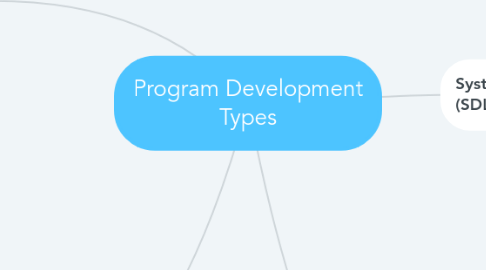
1. Rapid Application Development (RAD)
1.1. Process
1.1.1. A program development type that uses prototyping and user testing to develop a project.
1.2. Advantages
1.2.1. 1.RAD is an interactive process that uses reusable software components to help speed up development.
1.2.2. 2.RAD does not have structured process like SDLC which makes it more flexible and adaptable to user needs.
1.2.3. 3.RAD is user-driven and is ideal for developing software such as graphical user interfaces.
1.3. Disadvantages
1.3.1. Since RAD is not a structured model like SDLC it might be easy for developers to get lost while planning the project or not fully flush out their ideas for the project.
2. Agile Development
2.1. Process
2.1.1. Agile development is a incremental and iterative process in which the project team reevaluates the direction of the project every 2 weeks. Testing, reviewing, and adjustments are made during the evaluation process to reflect the needs of the business.
2.2. Advantages
2.2.1. 1.The agile development model is great for projects with time sensitive problems that need to be resolved.
2.2.2. 2.The iteration process allows the project team to change the direction of the project as the company they mare making it for changes.
2.3. Disadvantages
2.3.1. Because the direction of the project can change every two weeks it is possible for the development to continue indefinitely as the company decides what they want.
3. System Development Life Cycle (SDLC)
3.1. Process
3.1.1. 1. System Request
3.1.2. 2.Planning
3.1.3. 3.Analysis
3.1.4. 4.Design
3.1.5. 5.Implementation/Testing
3.1.6. 6.Maintenance
3.1.7. 7.Replace System (Return to #1)
3.2. Advantages
3.2.1. Well structured model that helps the project team properly plan a new system.
3.3. Diisadvantages
3.3.1. 1.SDLC gives little opportunity to revise a project as it moves through development phases.
3.3.2. 2.SDLC works best when the the system requirements are clear and structured.
4. Joint Application Development (JAD)
4.1. Process
4.1.1. Similar to the SDLC model but has a more collaborative process in which the end user is involves throughout the design and development of the project.
4.2. Advantages
4.2.1. The JAD model has shorter development times because of the continued involvement of the users throughout the process.
4.3. Disadvantages
4.3.1. While the JAD model helps developers understand the users needs it is possible for the project to become to complicated from trying to incorporate all the needs of the users involved in the development.
